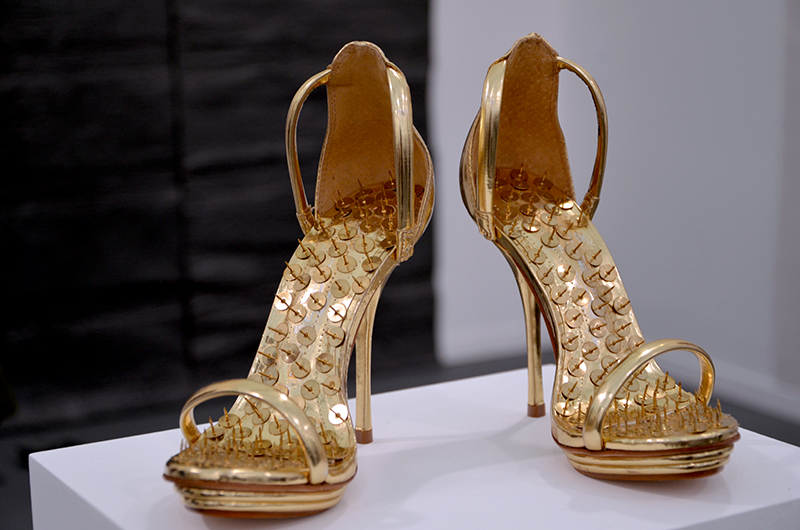They are just shapes…
I recently visited a new contemporary art fair where I stopped by a floor sculpture/installation that had all of the attributes of the kitchy, in-your-face, Instagram-ready derivative art we are accustomed to seeing at the big fairs. I stopped, determined to learn about the artist’s intentions with the work, I asked the booth attendant that simple question: what is her message with this work, what does she intend to say? What I got instead was a long story describing the technical process — mind you, not what I asked. And then came the answer: nothing. She doesn’t say anything in or with her work. “They are just shapes she likes”.
I’ll let you contemplate that for a while, only because there was a sizable price tag attached to “the shapes she likes”.
Oil, graphite, glue, brush bristles, sweat, tears, pencil and primer on canvas. But… is it “good” art?
Ahh, yes, the loaded question. What I mean is, is the contemporary art we see at fairs relevant? Is the sheer fact that the artist decided to manufacture brightly colored shapes she likes and place them on a mirror (without bothering to explain to the show rep the story behind her work) enough to feature it in an art fair? Maybe, but as collectors, as viewers, making an effort to engage with the work, I feel we deserve much more than a manifestation of what presented as a half-digested idea.

Hans-Peter Feldmann, Golden Shoes Massimo Minini at Frieze New York, 2014 Image © Kristina Nazarevskaia for galleryIntell
The reality is that much like the fashion world, commercially produced contemporary art we often see at fairs has largely come to resemble the mass produced, buyer-centric market. In an echo to the shopping mall comparison, buyers create demand and artists, rush to fill it. For instance, if collectors, with their ‘me too’ mentality indicate that Jeff Koons’, Richard Prince’s, Damien Hirst’s shiny and bright bag of ideas is what they want, Prince and the gang will fill the market with bright shiny, albeit superficial, balloon animals, neon signs, Popeyes and the like. Thus the financial resources, otherwise available for other art acquisitions are now allocated to the irrelevant, single-syllable, brash derivatives. And taking that mall comparison one step further, can an art-producing factory, like Warhol’s or Hirst’s really produce relevant work?
Does the pressure to sell at art fairs force the artist to manufacture ‘ready-mades’? I am referring more to the higher-end of the market here and the multitude of ‘echoes’ we seem to encounter fair after fair.
See it, capture it, produce it, sell it.
In this new paradigm of seemingly weekly art fairs where the financial pressures on both the gallery and the contemporary artist ultimately guide what is created and shown, the artist simply doesn’t have the time necessary to develop, test, live through and implement an idea complex and layered enough to survive over the long term.
 See it, capture it, produce it and sell it. Rinse and repeat, as one of the street art boards in Bushwick announced during the recent annual open studios. So, when it comes to considering the primary market works at the art fairs, should we be concerned that what we are looking is potentially not a conceptually complete work but perhaps a half-finished draft? Of course, the gallery doesn’t feature the same artist at every fair, but with the high stakes of each four-day event how much creativity and how much purely commercial calculation goes into creating each piece? It’s not a simple question to consider.
See it, capture it, produce it and sell it. Rinse and repeat, as one of the street art boards in Bushwick announced during the recent annual open studios. So, when it comes to considering the primary market works at the art fairs, should we be concerned that what we are looking is potentially not a conceptually complete work but perhaps a half-finished draft? Of course, the gallery doesn’t feature the same artist at every fair, but with the high stakes of each four-day event how much creativity and how much purely commercial calculation goes into creating each piece? It’s not a simple question to consider.
Galleries also often commission their artists to create new, heretofore unseen works specifically for the fair. Often even the gallery director will not have seen the work until it arrives at the fair. We know that because we often request information and images of the art ahead of the art fair and the gallery has very little information and often no images from the artist. This scenario places some unfair responsibilities on the artist and the gallery. For one, the artist must produce something unique and catchy enough to attract the attention of the collector.

Yan Pei-Ming Autoportrait en crane VII, 2007 Frieze New York. Image © Kristina Nazarevskaia for galleryIntell
What we found in the past several years and countless fairs visits, is that only a handful of artists have the means to dedicate the time and intellectual effort needed to produce deep, complex, engaging, sophisticated works that have the potential to sustain an intelligent conversation with the viewer for generations to come.
I am, by no means, negating the galleries’ curatorial decisions. That’s not the point or the intention of this article. What I am asking is do their motivations align with those of the collectors’ and the artists’? Or does the pressure to make money beyond covering the participation costs drive their curatorial choices?
Here at galleryIntell we arrive at the fair before it opens to the general public and talk to the galleriests during the VIP preview. We are then able to provide our viewers and readers with the curatorial information essential in understanding the work’s art historical significance and therefore its collectability. So unless you have this information beforehand it’s really a shot in the dark especially if you’re buying an unknown artist.
This article © galleryIntell






















